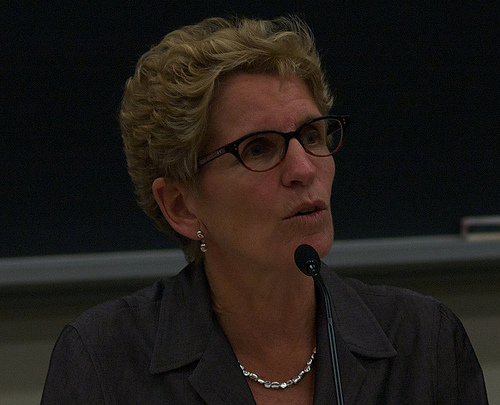More than 40 years after the start of the second wave of feminism, women have clearly made gains in the labour market through much activism on the streets, advocacy, and the courts. Job posting are no longer segregated by gender and overt gender discrimination is no longer an acceptable norm. Legislative gains have also been made to address systemic discrimination in the labour market. One measure of this progress is that for the first time in Ontario history two women, Kathleen Wynne and Andrea Horwath, will be decision makers about this year’s provincial budget.
However, these gains have been slow in coming, and continue to move too slowly. In 1991, the average earnings of Ontario women working full-time, full-year were 68.1 per cent of men’s. In 2010, that ratio was 76.1 per cent according to Statistics Canada Labour Force Survey data. This increase of 8 percentage points over a 19-year period still leaves a wage gap of 24 per cent between men and women. Despite the volumes spoken by this summary statistic, it still misses much of the difference in the labour market experience of men and women. Women continue to do different work than men, and that work is generally paid less than men’s work. Women are more likely to work part-time and have periods outside of the labour force while they take care of children or the elderly. The overall wage gap also does not capture the interaction of race and gender — racialized women in Ontario were paid 53.4 cents for every dollar non-racialized men were paid in 2005.
We can only hope that Horwath and Wynne will keep in mind the impact that austerity budgets have on women because of our greater responsibility for care-giving, segregated labour market, and lower incomes. In a recent op-ed, Professor Kathleen Lahey from Queen’s University outlined very clearly how the federal government’s tax cutting agenda has a disproportionately negative impact on women. In the first instance, because women earn less than men they benefit less from these tax cuts. And in the second, cutbacks in services have a disproportionately negative impact on women as compared to men, in areas like women’s health programs, Employment Insurance and the Old Age Security system.
In a paper for Alternative Routes I came to similar conclusions about the gender impact of the 2012 Ontario Budget. While it didn’t cut taxes, it did decrease real spending. And therein lies a major problem. This decrease will result in layoffs that will disproportionately affect women, because they comprise just over 60 per cent of Ontario public sector employees, as compared to 47 per cent of private sector ones. The impact of layoffs that result are then compounded by the differences in wages for women in the public and private sectors. On average, women employed in public sector jobs are paid 4.5 per cent more than women in comparable occupations in the private sector: $45,821 compared to $43,841. As a result, women who are laid off from the public sector will likely have difficulty finding employment with similar pay. On the other hand, men in the public sector are paid an average of 5.3 per cent less than those employed in the private sector: $57,318 compared to $60,531. Simply put, a decrease in public sector employment will tend to widen the gap between men and women’s wages.
The impact on women is not limited only to lost jobs. Shifts in the method of public service delivery also have a bigger impact on women. Private delivery of services and a shift to community–based health-care delivery moves women to more precarious employment situations, where they are less likely to be unionized and typically have lower compensation. Women will now be doing the same work, for less money, job security, and benefits.
Caregiving makes up a substantial portion of public services. When these services are reduced, the responsibility falls on women to pick up the slack. The loss of public services will increase unpaid work for women while reducing their incomes and opportunities for paid work.
As we approach International Women’s Day, the conversation about the gender impacts of policy decisions needs to be had, and with two women leaders at the decision-making table, there’s no better time to have it.
Photo: Paul Schreiber/Flickr




